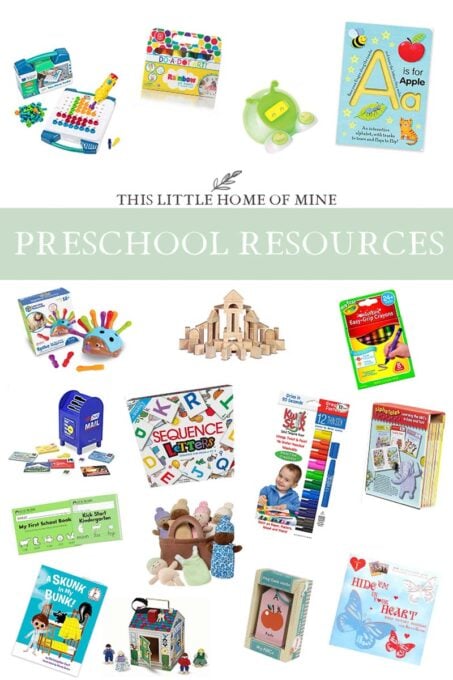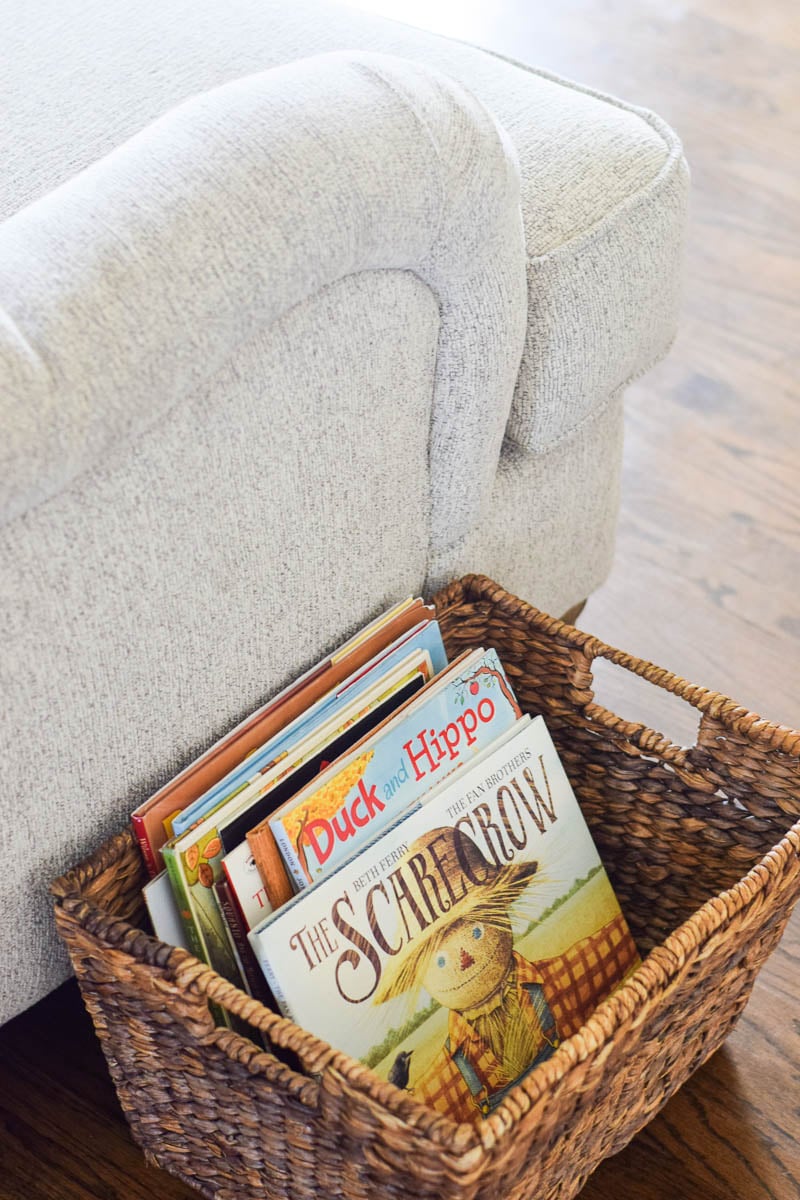Busy Bin Activity Boxes
What Are Busy Boxes?
They go by many names: busy bins, quiet bins, activity boxes, but the concept of these Busy Bin Activity Boxes is simple – and brilliant!

Fill small plastic bins with various sets of toys or activities that are unavailable at other times of the day.
This way, you have a low-prep ace up your sleeve when you need a quick activity to keep young ones occupied, without having to run around and gather up all of the supplies first!
I like to have five busy bins prepped and in the closet, one for each day of the week: Monday, Tuesday, Wednesday, Thursday, and Friday.
When To Use Busy Bin Activity Boxes
Early mornings. Is your toddler going through a bit of a rough patch of sleep where he wakes up every day at 4:30 am, bright-eyed and bushy-tailed?
There’s a temptation to turn on a show while you drink your coffee, but instead you can pull out one of your morning bins!
A little prep goes a long way for a smooth start to the day.
Homeschool days. Are young siblings a part of your family’s homeschool day?
One of the benefits of homeschooling is that the family can be together, so instead of shooing younger children away, give them their own “school work” in a busy box!
Need concentrated time to work with your younger children? Your older children might enjoy some busy box activities of their own.






Quiet times. Has your oldest child started to drop their midday nap – or maybe your oldest children are much older than that – but you still have babies and toddlers that require a quiet house during naptime?
A daily quiet time is actually super beneficial for a wide ranges of age, and you can set yourself up for success by supplying the older siblings with ready-made bins designed for quiet time activity.
New baby. Do you have a new baby in your family? It can sometimes feel hard to keep big brothers and sisters busy during the day when mom is drained of energy and oh-so-tired.
Use busy bins to help ease everyone through what can feel like a big transition. The boxes will add a little bit of excitement to each day, and are a great way to help each child feel noticed and valued.
A Few Practical Busy Bin Tips
Think about the day ahead! I’m in no way opposed to messes. In fact, I think messes are a crucial part of early childhood play and education!
But if you know that, say, Wednesdays are particularly busy and you have to hurry out to piano lessons right after homeschool is finished, keep that in mind when scheduling your busy box rotation.
Perhaps that would not be the ideal day to pull out the sensory bin full of rice and beans! That would be a better day for something that cleans up quickly and easily, like blocks.
Keep it all in the box. Make sure that every item needed for a certain activity is there in that box!
If you make a busy box that requires you to also pull out a few items from the kitchen to go long with it, that’s just more added work for you.
You want busy boxes to make your day easier, not add more tasks to it!
Use bins with lids. Maybe you’re a basket-lover. I get it! Plastic bins aren’t typically as pretty to look at, but they are perfect for busy boxes!

Clear bins allow you to easily see what items are inside each particular box.

Get our THIS LITTLE HOME OF MINE nEWSLETTER
Delivered directly to your inbox!

The lids make them stackable, which is a big plus – and they’re durable, making it easier for little hands to clean up after themselves.




Don’t have these kinds of bins on hand? No worries –
Especially if you’re trying to use what you already own and not spend any additional money right now.
Here are some pictures that might provide you with some inspiration!
Maybe you already have these kinds of things on hand.









Rotate activity types! Think about the different types of play and enrichment as your build your busy boxes.
Use some bins for sensory materials, others for fine motor skills – think VARIETY!
Some can be more craft-oriented while others perhaps include educational activities or toys.
When you swap out for a new box each day, you’ll not only be offering a different set of items, but you’ll also be moving to a different type of play!
Play is often talked about as if it were a relief from serious learning. But for children play is serious learning. Play is really the work of childhood. – Mr. Rogers
Ideas For Building Your Own Busy Bin Activity Boxes
Here are some of my favorite different activities for busy box ideas!
You probably have many of these items on hand already or being able to find them at a low price second-hand or at a discount or dollar store.
- Blocks – of all different kinds! This can include wood blocks, LEGOs/Duplos, those neat math manipulative blocks that connect together… any type of block makes for great independent play.









- Puzzles, simple games, and self-correcting activities – the sky’s the limit here, but here is some inspiration for you.













- Lacing challenges – like beads and string. You can scale down the difficulty if you’d like by swapping out the string for pipe cleaners. Yes, you string the beads onto the pipe cleaner. Or how about lacing cards or a different type of lacing activity? There are so many fun different kinds available these days – even some for older kids! Is your child working on learning how to tie their shoe? You could include a shoe tying activity in a busy bin for them!



- Stickers. This can be as simple as providing fun stickers and colored paper, or you could pick up those sticker books that are almost like sticker puzzles! Have your kids ever tried any of these Sticker by Number Books? For years, they have been in a favorite in our house!



- Drawing Books/Art Books chosen based on the age/stage of your child.












- Scooping challenges make a great sensory box. If you don’t have it in you to deal with rice or beans (I totally understand!), use pom poms. Try adding various tools such as cups, spoons, small containers, etc.







- Not every busy box has to be an enrichment activity! Fill one or two with a category of toys you already have on hand. For example, a once-a-week busy bin could include specific high-interest vehicle toys or dolls your child loves.
- Felt boards are fun! You can purchase them ready-made, or make your own by cutting thin felt into a variety of pieces, and see what scenes your child creates. Or how about building with popsicle sticks? These have been a favorite quiet-time activity in our house over the years!




- Play-Doh is a favorite for sure, and there are a wide variety of cutters and rollers you can put in the box with it.




- A busy box set that addresses scissor skills is great for little learners! It can include a supply list as simple as blunt-tipped scissors and paper. Maybe you’ve even drawn some lines on the paper. Or you could provide a variety of different textures to be cut: ribbons, straws, old greeting cards, cooked spaghetti, play dough, etc.







- Paper punches and construction paper will keep little children busy for a long time. Bonus points if you have different shapes of paper punches!
- Any other fine motor activities you already have on hand!








- Flash cards make the younger siblings feel like they’re doing “school” like the older children. You’ll be surprised at how much just this low-key regular exposure will help with letter recognition in the future!

Would your kids enjoy any having access to their own Busy Bin Activity Boxes?
Maybe you could even allow them to choose what goes in theirs!
You could encourage them to gather items from around the house that they love – or shop our Amazon storefront for more ideas!




Parents of Children with Special Needs
As a mom of a child with special needs, these activity boxes are the perfect opportunity for providing my oldest daughter with activities that make her occupational therapists smile.
Over the years, as she has grown, these boxes have adjusted and changed along with her! It’s exciting to see what kinds of things interest her as she explores independently.
Another great option for these boxes is providing them for siblings who may find themselves waiting in doctor’s office or therapy clinic waiting rooms.
Or maybe you have therapists who come into the home and you could use these as quiet-time activities for siblings to enjoy while you are overseeing a therapy session.
My hope is that this post provides you with some ideas that will be helpful to your unique family situation.









Does your child want to learn to play chess?